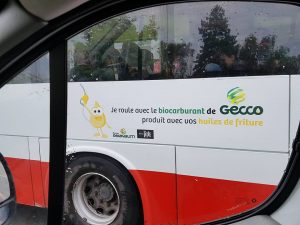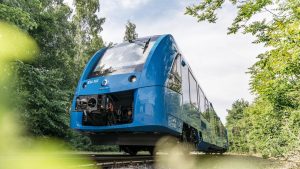Buses making their rounds thanks to sewage!
Northern Europe is world champion of clean transportation. Moreover, the city of Oslo (Norway) aims to become a “car-free capital” by 2020. Their main objective is to restrict the traffic of cars in the city center.Sweden has put in place a public transport network, which operates only through renewable energies. Buses run with wastewater and are 90% less polluting than before. The city of Stockholm no longer uses diesel or other fuel and is often referred to as a model of ecology.
In partnership with the French-Canadian operator Keolis, the city recovers wastewater and sends it directly to a biomethane production plant. Buses can cover a distance of 8 km, thanks to rechargeable batteries, in barely 6 minutes. The buses also have a hybrid biodiesel-electricity engine.
“In Stockholm, it is the waste of the city that produces gas to power the buses,” says Jean-Pierre Farandou, owner of Keolis and French operator responsible for the operation of a portion of the buses in Stockholm.This system is so conclusive that 90% of the pollution related to public transport is avoided. It is also 80,000 tons less CO2 sent into the atmosphere. That’s the equivalent of 40,000 gasoline cars in circulation.

Used Cooking oil for Fuel
Did you know that 95% of food oils used in restaurants or at home are usually incinerated, end up in the trash or in the sink? Dumping of used cooking oil is one of the main causes of water pollution in cities in Europe.
A French company has decided to give them a second life. Gecco recovers them in catering and also in recycling centers. One of their Belgian partners sells them to biodiesel plants in Europe.
This project called BIOHEC LIFE aims to develop a social economy sector based on the use of used food oils for the production of fuel from the environment.
According to Alicia Bachelet, this project was born from a report. “A territory generates waste and therefore needs energy. But with a little imagination, this waste can become the energy of the territory.”Transforming this type of waste into an alternative resource to oil and natural gas is a well-oiled inspiration!

Germany: Launch of the world’s first hydrogen train
Good news for the planet! Germany has put into service the first passenger trains in the world, fueled by a hydrogen fuel cell.It’s a real zero-emission revolution with little noise. Especially since these trains emit only water vapor and condensed water. Equipped with fuel cells, they transform the hydrogen stored on the roof and ambient oxygen into electricity.Lithium ion batteries also make it possible to store the energy recovered during braking for reuse in the acceleration phases
“With the hydrogen fuel cell, we are betting on the future to meet the challenge of reducing CO2 emissions and meeting the huge needs of clean public transport.” Said Jörg Nikutta, head of the German division of Alstom.
According to Le Figaro, a recent study by the Hydrogen Council, hydrogen could account for nearly a fifth of the total energy consumed by 2050. “This would contribute up to 20% of the reduction required to limit global warming to 2 ° C.” Says the Hydrogen Council. According to this study, hydrogen could supply 10 to 15 million cars and 500,000 trucks by 2030. The annual demand for hydrogen could globally be multiplied by ten by 2050. It represents 18% of the energy demand total final in the 2 ° C scenario.
In the long term, hydrogen could generate a turnover of 2500 billion dollars and create more than 30 million jobs.

Inauguration of Africa’s largest wind farm
With a population of some 1.2 billion, the African continent is the second most populous continent, but, paradoxically, the least electrified. 665 million people are reported to live without electricity on a daily base, Is a big an issue!
Polluting energies and lack of accessibility.
Flame thermal power plants are coal, oil or natural gas power plants. It is the most widespread energy model on the African continent. Their mode of operation is simple: the heat released by the combustion of fuel oil, gas or coal is used to produce energy.
However, this type of energy is not without risk to the environment. In addition to generating emissions of pollutants and greenhouse gases, the use of thermal energy depends on fossil sources with physically limited and non-renewable reserves.
According to the World Bank, in sub-Saharan Africa, the electricity grid covers only a very small part of the countries. In addition, electricity, which is quite expensive, can cost up to 3 times more than in America. Under these conditions, the most modest households unfortunately do not have the means to benefit from the current and remain in darkness.
Kenya’s choice seems to be an interesting and encouraging path for the future.
Life-saving solutions for the future?
Renewable energies, including wind energy, are energies that do not require any fuel. Considered clean, wind does not create a greenhouse effect and does not produce radioactive and toxic waste. It is free energy, available in one of the windiest places in the world.
On July 19, Kenyan President Uhuru Kenyatta inaugurated the country’s first wind farm. The colossal infrastructure includes 365 wind turbines with a production capacity of 310 megawatts. Installation cost ? $879 million.
This project will increase the country’s electricity production by 13% and reduce dependence on any other energy source. It will also protect the country in the event of droughts and shortages, as it will ensure the supply of energy needed for the country to function properly.
Today, 85% of Kenya’s energy is renewable. Something to inspire many others.
Come on Canada! Get moving on alternative fuels. Catch up to the rest of the world. We have loads of sewage (no kidding), used canola oil and, Lord knows, the prairies have an abundance of wind.

No comments:
Post a Comment
Through this ever open gate
None come too early
None too late
Thanks for dropping in ... the PICs